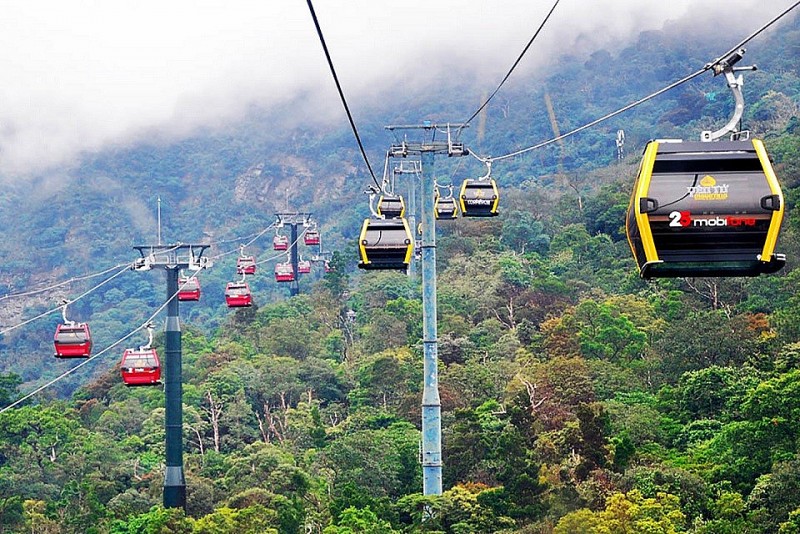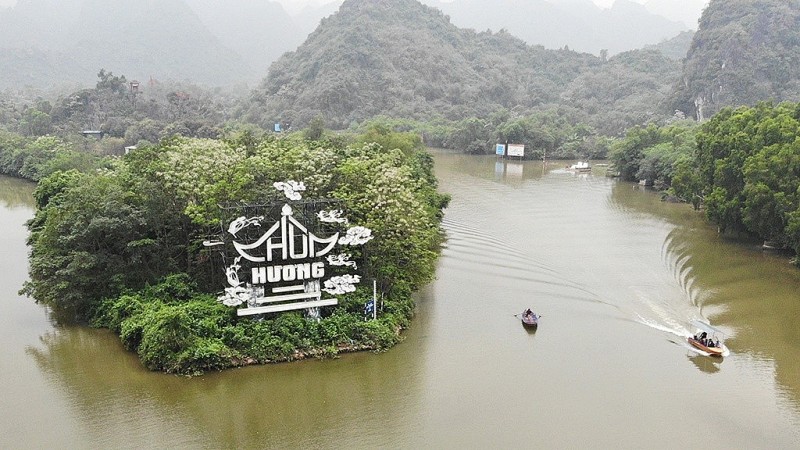
Trillion-dollar cable car route connecting Huong pagoda to Tien pagoda:
Huong Binh cable: More jobs and livelihoods to be brought to Muong ethnic people in Hoa Binh
Latest
The Huong Binh cable car route is nearly 3 km long, connecting the scenic Long Van pagoda (within the Huong pagoda complex) in My Duc district (Hanoi) and the Tien pagoda (within the Tien pagoda cave complex) in Lac Thuy district (Hoa Binh) will start its construction and installation in 2022, it is scheduled to operate in the fourth quarter of 2024. This is considered an opportunity for the Muong ethnic people in Lac Thuy to have more favourable conditions for socio-economic development.
 |
| The cable car connecting Long Van and Tien pagodas represents a significant contribution to realizing the goal of making Lac Thuy an attractive tourist destination of Hoa Binh province and its vicinity. (Source: VnFinance) |
Boosting the local economy
It is estimated that the cable car route will shorten the distance and travel time between Long Van and Tien pagodas from 45km by road (about 60 minutes by car) to about 3km by cable car (10-minute travel).
Experts say that the construction of the Huong Binh cable car route not only improves the traffic connection between the two famous monuments (Long Van and Tien pagoda) but also creates favorable conditions and shortens the travel distance and time when moving back and forth between the two landmarks; contributing to improving the quality of tourism services, promoting the socio-economic development of the two localities.
In 2006, the first cable car system at Huong Pagoda was put into operation with 45 cars passing through 3 stations (Thien Tru, Giai Oan and Huong Tich), with a total length of more than 1 km. Each cabin can carry 6 passengers and this system can transport about 1,000 guests every hour, increasing the total number of visitors to Huong Pagoda.
As for Tien Pagoda (within the Tien Pagoda cave complex), the place was recognized as a national relic by the Ministry of Culture, Sports and Tourism in 2011. The pagoda is located in the mountainous district of Lac Thuy of Hoa Binh province, with the Muong ethnic people accounting for 34.5% of the local population.
According to annual statistics, the number of tourists visiting the Tien pagoda is nearly 600,000 visitors and the number of visitors going to Huong pagoda combined with tourism is about 1.5 million. According to the officials of Lac Thuy district, the district identifies tourism and related services as an important economic sector in the economic structure of the district.
Therefore, the introduction of a cable car connecting Long Van Pagoda and Tien Pagoda will make a significant contribution to making Lac Thuy an attractive tourist destination in Hoa Binh province and its vicinity. Typical products are cultural, spiritual tourism, research, ecology, and convalescence stay, associated with understanding the cultural identities of the ethnic groups. Therefore, it is a contribution to local economic development, with more employment, and increased income for the community.
Notably, with more than 20 relic sites, including many types such as historical, cultural, archaeological, and scenic sites, visitors to Tien Pagoda not only enjoy and explore the mysterious cave system, but also mingle with the cultural and artistic activities of the Muong ethnic people, such as bamboo dancing; folk games such as walking on stilts, swinging, tossing lucky balls.
Safety and effectiveness to be ensured
The Deputy Prime Minister Le Van Thanh signed the decision approving the investment, and concurrently approved the investor of Huong Binh cable car project in Phu Nghia commune, Lac Thuy district, Hoa Binh province, and Huong Son commune, My Duc district, Hanoi City. The investor of the project is Thai Binh Tourism One Member Limited Liability Company.
The investment capital of the project (including site clearance costs) is VND 1,726 billion. The project operation duration is 50 years from March 16, 2022. The total land use area of the project (both Hoa Binh and Hanoi terminals) is 35.05ha. In which, in Hoa Binh province about 17.19 ha; including main items: engine station; hotels, resort villas, restaurants, marinas, main entrance gates, observation service huts.
In Hanoi, the land use area is about 17.86 ha, including the main items: Main station and subordinate functions (administrative office area, ticket counter, medical room, souvenir shops); technical area - cable car operation & control (cabin, technical room...); reception area and waiting hall for passengers to wait in line before boarding the cabin; the cable car route services (waiting house); the huts for landing; green land area to create landscape and a place to rest for tourists.
 |
| The inter-provincial cable car route from Hoa Binh is designed to connect the scenic Tien Pagoda in Lac Thuy district to the Huong (Perfume) Pagoda in My Duc district, Hanoi. (Source: Thanh Nien Newspaper) |
The Prime Minister assigned the Ministry of Culture, Sports and Tourism to guide, inspect and supervise the construction investment, usage and operation of the project to ensure compliance with regulations; The Ministry of Natural Resources and Environment supervises the allocation of land, conversion of land use purposes, and environmental protection; absolutely to ensure no negative, wasteful, loss of state property.
The People's Committees of Hoa Binh Province and Hanoi City have the responsibility to monitor, inspect and supervise the project implementation, to ensure compliance with legal regulations; to ensure no unwanted activities that adversely affect the people and damage the environment, causing lawsuits and complaints, especially in site clearance, compensation, and resettlement support.
The investor is expected to take full accountability for the information, reported data and commitments in the project record files; effectively use, for the right purposes, fully mobilize resources to implement the project on schedule; selection and use of modern technology and equipment, advanced techniques in construction and operation of cable cars, ensuring safety and efficiency in cable car operation.
| It is expected that the designed capacity of the Huong Binh cable car route after completion will meet the transport demand of about 1,500-2,000 passengers/hour, equivalent to 12,000-16,000 passengers/day. With the participation of the tourism service industry, the local people will have more jobs and increase their income, thereby contributing to changing the socio-economic face of the locality, especially in the mountainous districts such as Lac Thuy with great potentiality. |

















